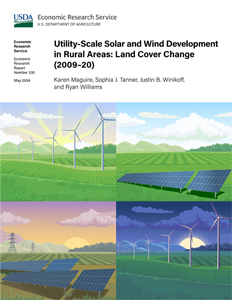Utility-Scale Solar and Wind Development in Rural Areas: Land Cover Change (2009–20)
- by Karen Maguire, Sophia Tanner, Justin B. Winikoff and Ryan Williams
- 5/21/2024
Overview
This report examines land cover and land cover change associated with solar and wind farms over the period 2009–20. Wind development has been expanding since the late 1990s and comprises a larger share of renewable capacity than solar; most solar farms were installed after 2016. Due to decreasing costs and new or existing policies promoting renewable development, the pace is expected to increase. The amount of land cover directly affected by solar and wind is estimated to be small relative to the amount of farmland. Still, more than 90 percent of wind turbines and 70 percent of solar farms in rural areas were sited on agricultural land. There are large regional differences in the distribution of solar and wind development. Further, even in years where no development occurred, land cover changed more frequently on land used for solar than wind, suggesting that solar and wind were sited on different types of land. Agricultural land surrounding wind turbines typically maintained agricultural land cover after development, while approximately 15 percent of land surrounding solar farms shifted out of agriculture. This suggests that wind is compatible with agriculture and that there is some land use competition between farmland and solar farms.
How to Cite:
Maguire, K., Tanner, S., Winikoff, J.B., & Williams, R. (2024). Utility-scale solar and wind development in rural areas: Land cover change (2009–20) (Report No. ERR-330). U.S. Department of Agriculture, Economic Research Service. https://doi.org/10.32747/2024.8374829.ers
Download
-
Entire report
Download PDF -
Report summary
Download PDF
We’d welcome your feedback!
Would you be willing to answer a few quick questions about your experience?

